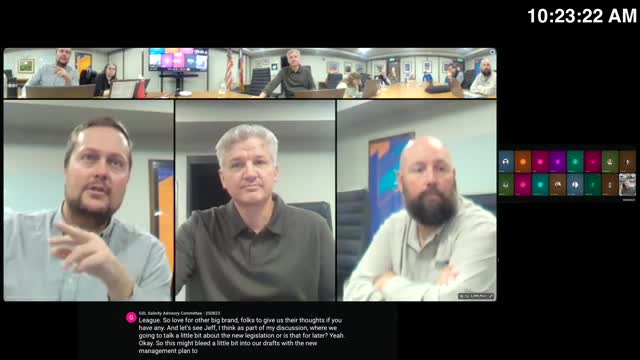Draft salinity management plan discussed; new legislation broadened objectives and committee weighs monitoring and operational tools
October 24, 2025 | Utah Great Salt Lake Advisory Council, Boards and Commissions, Organizations, Utah Executive Branch, Utah
This article was created by AI summarizing key points discussed. AI makes mistakes, so for full details and context, please refer to the video of the full meeting. Please report any errors so we can fix them. Report an error »

Committee members reviewed the draft salinity management plan and discussed how new state legislation affects operational options for berm and breach management.
A Division staff member summarized recent developments, saying a special legislative session produced a bill that changes the effective dates and language governing berm operations and, as read in the meeting, allows consideration of additional objectives beyond salinity alone (for example, potential microbial or dust-related considerations) when making operational decisions. The staff member emphasized the bill "does not allow us to close off the North Arm forever" and that the change gives managers more flexibility to weigh multiple objectives when considering raising or lowering a berm.
Committee members discussed monitoring needs to support decisions. Participants recommended continued monthly sampling in the South Arm (GSLIP's program) and higher-frequency or supplemental sampling in the North Arm and near the breaches; suggestions included maintaining Saltair (Solterra) high-frequency samples while adding the computed volume-weighted metric as a monthly public series. The committee identified LVG-4, RD-2 (bridal jetty area) and Spiral Jetty or causeway-adjacent sites as useful long-term reference sites for the North Arm and asked staff to ensure gauge continuity near the breaches.
Biological data were also discussed. A presenter summarized three decades of brine shrimp (Artemia) research and noted that hatchability and survival decrease with higher salinity but that cyst buoyancy and hatch response are temporally variable. The presenter recommended keeping a spring target salinity range (discussed during the meeting) of roughly 90 to 130 grams per liter, with a working operational target of about 120 grams per liter for autumn conditions (committee members proposed October 15 as the practical date for autumn assessment). The presenter cautioned that freshwater lenses can improve hatchability but are not wholly reliable in every year; the historical harvest-management thresholds already account for lens effects.
On the planning timeline, staff said Jacobs Engineering remains the contractor for the CMP, a final draft is expected to be completed in early 2026, and the group hopes to initiate a formal public review in spring (March) 2026. Staff also noted legal concerns linked to a pending lawsuit had slowed some work but that the division intends to continue developing management options. Members suggested keeping the CMP "timeless" by framing objectives (import/export salt, monitoring thresholds) rather than locking the document to a single operational tool (the berm). No formal vote was taken on the plan itself at the meeting.
A Division staff member summarized recent developments, saying a special legislative session produced a bill that changes the effective dates and language governing berm operations and, as read in the meeting, allows consideration of additional objectives beyond salinity alone (for example, potential microbial or dust-related considerations) when making operational decisions. The staff member emphasized the bill "does not allow us to close off the North Arm forever" and that the change gives managers more flexibility to weigh multiple objectives when considering raising or lowering a berm.
Committee members discussed monitoring needs to support decisions. Participants recommended continued monthly sampling in the South Arm (GSLIP's program) and higher-frequency or supplemental sampling in the North Arm and near the breaches; suggestions included maintaining Saltair (Solterra) high-frequency samples while adding the computed volume-weighted metric as a monthly public series. The committee identified LVG-4, RD-2 (bridal jetty area) and Spiral Jetty or causeway-adjacent sites as useful long-term reference sites for the North Arm and asked staff to ensure gauge continuity near the breaches.
Biological data were also discussed. A presenter summarized three decades of brine shrimp (Artemia) research and noted that hatchability and survival decrease with higher salinity but that cyst buoyancy and hatch response are temporally variable. The presenter recommended keeping a spring target salinity range (discussed during the meeting) of roughly 90 to 130 grams per liter, with a working operational target of about 120 grams per liter for autumn conditions (committee members proposed October 15 as the practical date for autumn assessment). The presenter cautioned that freshwater lenses can improve hatchability but are not wholly reliable in every year; the historical harvest-management thresholds already account for lens effects.
On the planning timeline, staff said Jacobs Engineering remains the contractor for the CMP, a final draft is expected to be completed in early 2026, and the group hopes to initiate a formal public review in spring (March) 2026. Staff also noted legal concerns linked to a pending lawsuit had slowed some work but that the division intends to continue developing management options. Members suggested keeping the CMP "timeless" by framing objectives (import/export salt, monitoring thresholds) rather than locking the document to a single operational tool (the berm). No formal vote was taken on the plan itself at the meeting.
View full meeting
This article is based on a recent meeting—watch the full video and explore the complete transcript for deeper insights into the discussion.
View full meeting

